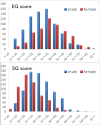Empathizing associates with mean diffusivity
- PMID: 31222093
- PMCID: PMC6586867
- DOI: 10.1038/s41598-019-45106-1
Empathizing associates with mean diffusivity
Abstract
Empathizing is defined as "the drive to identify another's mental states and to respond to these with an appropriate emotion" and systemizing is defined as "the drive to the drive to analyze and construct rule-based systems". While mean diffusivity (MD) has been robustly associated with several cognitive traits and disorders related with empathizing and systemizing, its direct correlation with empathizing and systemizing remains to be investigated. We undertook voxel-by-voxel investigations of regional MD to discover microstructural correlates of empathizing, systemizing, and the discrepancy between them (D score: systemizing - empathizing). Whole-brain analyses of covariance revealed that across both sexes, empathizing was positively correlated with MD of (a) an anatomical cluster that primarily spreads in the areas in and adjacent to the left dorsolateral prefrontal cortex, left anterior to the middle cingulate cortex, and left insula and (b) an anatomical cluster of the left postcentral gyrus and left rolandic operculum. The former overlaps with positive MD correlates of cooperativeness. The D score and systemizing did not show significant correlations. In conclusion, while increased MD has generally been associated with reduced neural tissues and possibly area function, higher empathizing and cooperativeness were commonly reflected by greater MD values in areas (a) that mainly overlap with areas that play a key role in emotional salience and empathy. In addition, higher empathizing was correlated with greater MD values in areas (b) that play a key role in the mirror neuron system.
Conflict of interest statement
The authors declare no competing interests.
Figures




Similar articles
-
White matter structures associated with empathizing and systemizing in young adults.Neuroimage. 2013 Aug 15;77:222-36. doi: 10.1016/j.neuroimage.2013.04.004. Epub 2013 Apr 8. Neuroimage. 2013. PMID: 23578577
-
Association between resting-state functional connectivity and empathizing/systemizing.Neuroimage. 2014 Oct 1;99:312-22. doi: 10.1016/j.neuroimage.2014.05.031. Epub 2014 May 17. Neuroimage. 2014. PMID: 24844739
-
Regional gray matter volume is associated with empathizing and systemizing in young adults.PLoS One. 2014 Jan 7;9(1):e84782. doi: 10.1371/journal.pone.0084782. eCollection 2014. PLoS One. 2014. PMID: 24409308 Free PMC article.
-
Digit ratio 2D:4D in relation to autism spectrum disorders, empathizing, and systemizing: a quantitative review.Autism Res. 2012 Aug;5(4):221-30. doi: 10.1002/aur.1230. Epub 2012 Jun 1. Autism Res. 2012. PMID: 22674640 Review.
-
The Empathy and Systemizing Quotient: The Psychometric Properties of the Dutch Version and a Review of the Cross-Cultural Stability.J Autism Dev Disord. 2015 Sep;45(9):2848-64. doi: 10.1007/s10803-015-2448-z. J Autism Dev Disord. 2015. PMID: 25911303 Free PMC article. Review.
Cited by
-
Sensory processing sensitivity and axonal microarchitecture: identifying brain structural characteristics for behavior.Brain Struct Funct. 2022 Nov;227(8):2769-2785. doi: 10.1007/s00429-022-02571-1. Epub 2022 Sep 24. Brain Struct Funct. 2022. PMID: 36151482 Free PMC article.
-
Macro- and micro-structural cerebellar and cortical characteristics of cognitive empathy towards fictional characters in healthy individuals.Sci Rep. 2021 Apr 22;11(1):8804. doi: 10.1038/s41598-021-87861-0. Sci Rep. 2021. PMID: 33888760 Free PMC article.
-
Mean diffusivity associated with trait emotional intelligence.Soc Cogn Affect Neurosci. 2019 Aug 31;14(8):871-883. doi: 10.1093/scan/nsz059. Soc Cogn Affect Neurosci. 2019. PMID: 31593230 Free PMC article.
-
Neurobehavioral indices of gaze perception are associated with social cognition across schizophrenia patients and healthy controls.J Psychopathol Clin Sci. 2023 Aug;132(6):733-748. doi: 10.1037/abn0000846. Epub 2023 Jun 29. J Psychopathol Clin Sci. 2023. PMID: 37384487 Free PMC article.
-
Rapid neuroplasticity changes and response to intravenous ketamine: a randomized controlled trial in treatment-resistant depression.Transl Psychiatry. 2023 May 9;13(1):159. doi: 10.1038/s41398-023-02451-0. Transl Psychiatry. 2023. PMID: 37160885 Free PMC article. Clinical Trial.
References
-
- Baron-Cohen, S. The essential difference: The truth about the male and female brain. (Perseus Books Group, New York, 2003).
-
- Baron-Cohen S, Richler J, Bisarya D, Gurunathan N, Wheelwright S. The systemizing quotient: an investigation of adults with Asperger syndrome or high–functioning autism, and normal sex differences. Philosophical Transactions of the Royal Society of London B: Biological Sciences. 2003;358:361–374. doi: 10.1098/rstb.2002.1206. - DOI - PMC - PubMed
-
- Baron-Cohen S, Richler J, Bisarya D, Gurunathan N, Wheelwright S. The systemizing quotient: an investigation of adults with Asperger syndrome or high-functioning autism, and normal sex differences. Philosophical Transactions of the Royal Society of London. Series B: Biological Sciences. 2003;358:361–374. doi: 10.1098/rstb.2002.1206. - DOI - PMC - PubMed
Publication types
MeSH terms
LinkOut - more resources
Full Text Sources
Molecular Biology Databases

